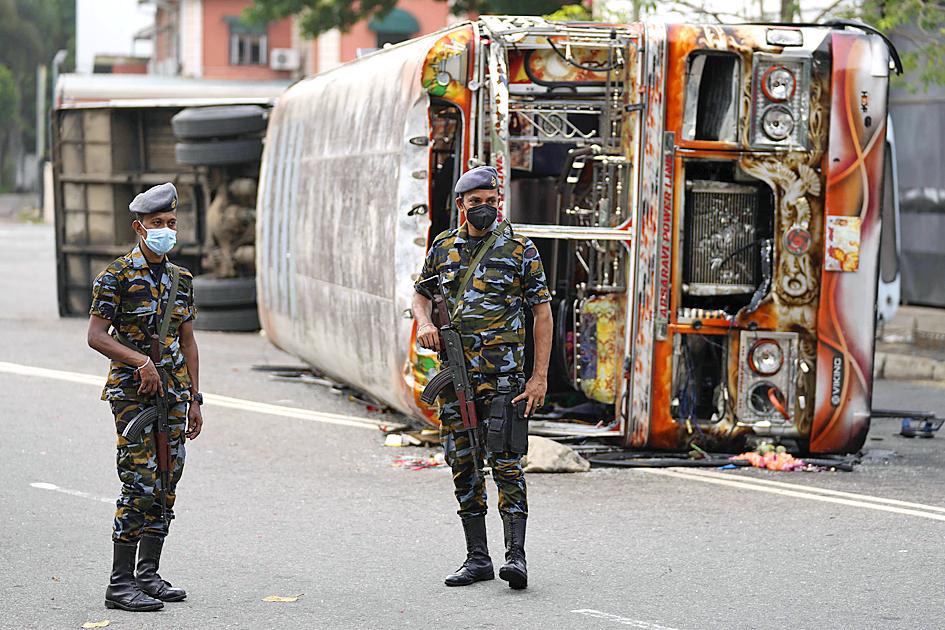Sri Lanka yesterday deployed thousands of troops and police to enforce a curfew after five people were killed in the worst violence in weeks of protests over an unprecedented economic crisis.
Nearly 200 were also wounded on Monday as Mahinda Rajapaksa resigned as prime minister, but that did little to calm public anger.
Rajapaksa had to be rescued in a pre-dawn operation by the military yesterday, after thousands of anti-government protesters stormed his official residence in Colombo overnight, with police firing tear gas and warning shots to keep back the crowd.

Photo: AP
“After a pre-dawn operation, the former PM and his family were evacuated to safety by the army,” a top security official said. “At least 10 petrol bombs were thrown into the compound.”
The Rajapaksa clan’s hold on power has been shaken by months of blackouts and shortages in Sri Lanka, the worst economic crisis since its independence in 1948.
However, Sri Lankan President Gotabaya Rajapaksa remains in office, with widespread powers and command over the security forces.
After weeks of overwhelmingly peaceful anti-government demonstrations, violence broke out on Monday when Mahinda Rajapaksa’s supporters — bused into the capital from the countryside — attacked protestors with sticks and clubs.
“We were hit, the media were hit, women and children were hit,” one witness said, asking not to be named.
Police fired tear gas and water cannons to disperse crowds and declared an immediate curfew in Colombo, a measure that was later widened to include the entire South Asian nation of 22 million people.
Authorities said that the curfew would be lifted this morning, with government and private offices, as well as shops and schools, ordered to remain shut yesterday.
US Ambassador to Sri Lanka Julie Chung wrote on Twitter that Washington condemned “the violence against peaceful protestors,” and called on the Sri Lankan “government to conduct a full investigation, including the arrest & prosecution of anyone who incited violence.”
Anti-government protesters defied police despite the curfew to retaliate against government supporters for the attacks late into Monday night.
Outside Colombo, Sri Lankan lawmaker Amarakeerthi Athukorala, of the ruling Sri Lanka Podujana Peramuna party, shot two people — killing a 27-year-old man — after being surrounded by a mob of anti-government protesters, police said.
“He then took his own life with his revolver,” a police official said.
Athukorala’s bodyguard was also found dead at the scene, police said.
Another ruling party politician who was not named opened fire on protesters, killing two and wounding five in the deep south of the island, police said.
Angry crowds set alight the homes of more than a dozen pro-Rajapaksa politicians, along with some vehicles, while buses and trucks used by the government loyalists in and around Colombo were also targeted.
Several Rajapaksa homes were torched in different parts of the country, while a family museum in their ancestral village was trashed.
Doctors at the main Colombo National Hospital intervened to rescue wounded government supporters, with soldiers breaking open locked gates to ferry in the wounded.
“They may be murderers, but for us they are patients who must be treated first,” a doctor shouted at a mob blocking the entrance to the emergency unit.

Malaysia yesterday installed a motorcycle-riding billionaire sultan as its new king in lavish ceremonies for a post seen as a ballast in times of political crises. The coronation ceremony for Malaysia’s King Sultan Ibrahim, 65, at the National Palace in Kuala Lumpur followed his oath-taking in January as the country’s 17th monarch. Malaysia is a constitutional monarchy, with a unique arrangement that sees the throne change hands every five years between the rulers of nine Malaysian states headed by centuries-old Islamic royalty. While chiefly ceremonial, the position of king has in the past few years played an increasingly important role. Royal intervention was

X-37B COMPARISON: China’s spaceplane is most likely testing technology, much like US’ vehicle, said Victoria Samson, an official at the Secure World Foundation China’s shadowy, uncrewed reusable spacecraft, which launches atop a rocket booster and lands at a secretive military airfield, is most likely testing technology, but could also be used for manipulating or retrieving satellites, experts said. The spacecraft, on its third mission, was last month observed releasing an object, moving several kilometers away and then maneuvering back to within a few hundred meters of it. “It’s obvious that it has a military application, including, for example, closely inspecting objects of the enemy or disabling them, but it also has non-military applications,” said Marco Langbroek, a lecturer in optical space situational awareness at Delft

The Philippine Air Force must ramp up pilot training if it is to buy 20 or more multirole fighter jets as it modernizes and expands joint operations with its navy, a commander said yesterday. A day earlier US National Security Adviser Jake Sullivan said that the US “will do what is necessary” to see that the Philippines is able to resupply a ship on the Second Thomas Shoal (Renai Shoal, 仁愛暗沙) that Manila uses to reinforce its claims to the atoll. Sullivan said the US would prefer that the Philippines conducts the resupplies of the small crew on the warship Sierra Madre,

AIRLINES RECOVERING: Two-thirds of the flights canceled on Saturday due to the faulty CrowdStrike update that hit 8.5 million devices worldwide occurred in the US As the world continues to recover from massive business and travel disruptions caused by a faulty software update from cybersecurity firm CrowdStrike, malicious actors are trying to exploit the situation for their own gain. Government cybersecurity agencies across the globe and CrowdStrike CEO George Kurtz are warning businesses and individuals around the world about new phishing schemes that involve malicious actors posing as CrowdStrike employees or other tech specialists offering to assist those recovering from the outage. “We know that adversaries and bad actors will try to exploit events like this,” Kurtz said in a statement. “I encourage everyone to remain vigilant